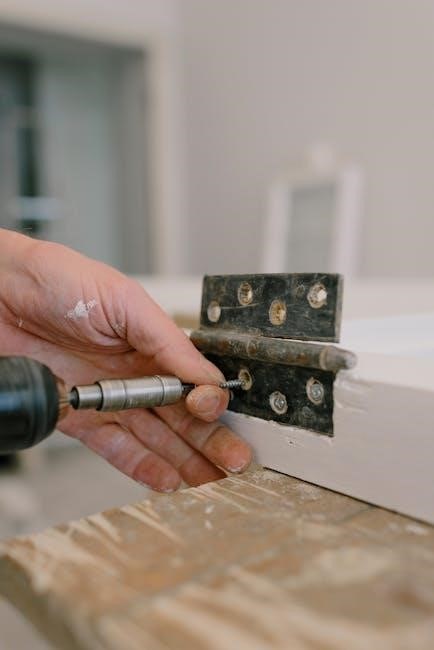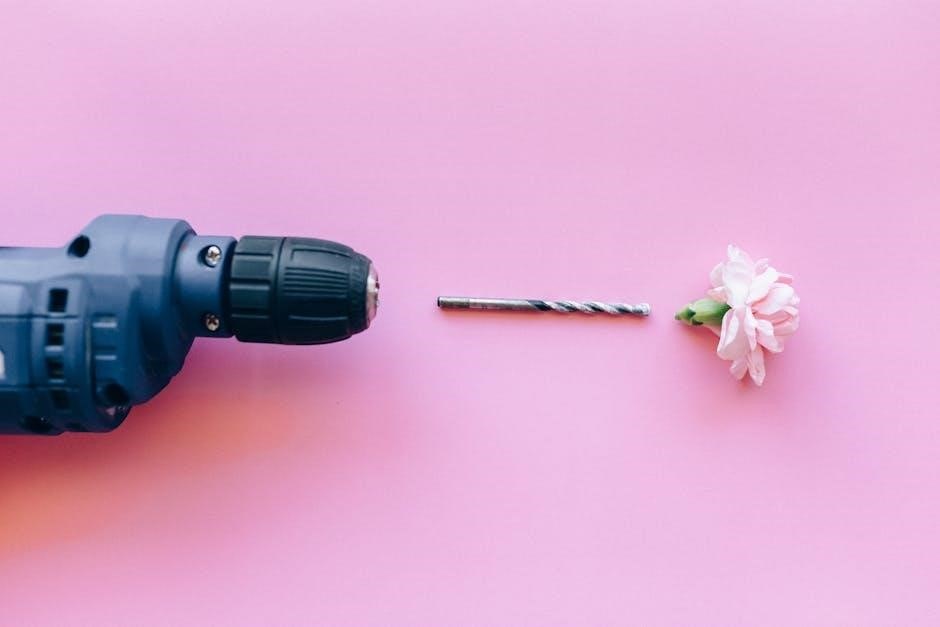A manual worker in New York, as defined by the Labor Law, includes mechanics, laborers, and workingmen. The New York Department of Labor interprets this to include anyone spending over 25% of their time on physical labor, ensuring they receive weekly wages as mandated by law.
Definition and Overview of Manual Workers in New York
A manual worker in New York, as per Section 190(4) of the Labor Law, is defined as a mechanic, workingman, or laborer. The New York Department of Labor expands this definition, classifying individuals who spend at least 25% of their working time in physical labor as manual workers. This broader interpretation ensures workers in various roles, including retail and service industries, qualify for weekly wage protections. The classification is crucial for ensuring compliance with payment regulations and safeguarding workers’ rights under state labor laws.

Historical Background
New York’s labor laws originated in the early 20th century, focusing on protecting workers. Key legislative changes have evolved to address fair pay and workers’ rights, ensuring compliance and adapting to modern workforce needs.
Evolution of Labor Laws in New York State
New York’s labor laws have evolved significantly over the decades, with a focus on protecting workers’ rights. Early 20th-century reforms addressed wages and working conditions, while recent amendments to Section 191 of the Labor Law clarified payment frequencies for manual workers. The state has continuously updated its regulations to align with changing workforce dynamics, ensuring fair compensation and timely payments. These changes reflect a commitment to safeguarding employees’ interests and adapting to modern labor practices, providing a robust framework for employers and employees alike.
Significant Legislative Changes Affecting Manual Workers
Recent updates to New York Labor Laws have expanded protections for manual workers, particularly through amendments to Section 191. These changes clarify payment schedules and eligibility, ensuring timely wages. The 25% physical labor threshold remains a key factor in defining manual workers, influencing court rulings. Notably, cases like the GameStop lawsuit have prompted reevaluations of worker classifications, reflecting evolving interpretations of labor roles. These legislative adjustments underscore the state’s efforts to modernize labor protections, addressing contemporary workplace dynamics and ensuring fair compensation for manual workers across various industries.

Legal Definition
New York Labor Law defines a manual worker under Section 190(4) as a mechanic, workingman, or laborer. The New York Department of Labor interprets this to include anyone spending at least 25% of their time on physical labor, ensuring clarity in worker classification and wage entitlements.
Section 190(4) of the New York State Labor Law
Section 190(4) of the New York State Labor Law defines a manual worker as a mechanic, workingman, or laborer. This legal definition is the foundation for determining who qualifies as a manual worker under state law. The New York Department of Labor further interprets this section to include individuals who spend at least 25% of their working time engaged in physical labor, ensuring clarity in worker classification. This definition is crucial for employers to properly classify employees and comply with wage payment requirements, specifically the mandate for weekly payments to manual workers.
New York Department of Labor’s Interpretation
The New York Department of Labor (NYDOL) interprets the term “manual worker” beyond the statutory definition, emphasizing that any individual spending at least 25% of their working time engaged in physical labor qualifies. This interpretation expands the scope to include roles not explicitly listed in Section 190(4), ensuring modern applicability. The NYDOL’s guidelines provide clarity for employers in classifying employees and adhering to wage payment laws. This interpretation is crucial for compliance, as it affects payment frequency and worker protections, particularly for those in roles involving significant physical activity, regardless of traditional job titles or industries. Accurate classification is essential to avoid disputes and ensure fair labor practices.
Categories of Manual Workers
Manual workers in New York include mechanics, laborers, and workingmen. Beyond traditional roles, the category now encompasses diverse occupations requiring physical labor, reflecting broader labor law interpretations.
Mechanics, Workingmen, and Laborers
Mechanics, workingmen, and laborers form the core categories of manual workers under New York Labor Law. Mechanics are skilled tradespeople, such as carpenters or electricians, while workingmen encompass construction and manufacturing roles. Laborers are those engaged in physical tasks requiring manual strength, like movers or factory workers. These classifications ensure workers receive weekly wages and legal protections, reflecting the state’s commitment to fair labor practices and clear distinctions in employment roles to prevent exploitation and ensure timely compensation for physical labor contributions.
Expansion of Categories Beyond Traditional Roles
The definition of manual workers in New York has evolved beyond traditional roles. While mechanics, workingmen, and laborers remain core categories, the New York Department of Labor now recognizes workers in retail and service industries who perform physical tasks. For instance, retail workers spending significant time on their feet or handling heavy objects may qualify. This expansion aligns with modern work dynamics, ensuring broader protection under labor laws. The state’s interpretation now includes roles not historically classified as manual labor, reflecting efforts to adapt labor regulations to contemporary workplace realities and safeguard employees in diverse industries.

Payment Regulations
New York State Labor Law mandates manual workers be paid weekly, while clerical and other workers must receive wages at least twice a month.
Weekly Payment Requirements for Manual Workers
Under New York Labor Law, manual workers must receive wages weekly, not exceeding seven days after the work week ends. This ensures timely compensation for physical labor. Employers must adhere to this schedule, with limited exceptions. Failure to comply results in penalties and potential legal action. The law aims to protect workers by preventing wage delays and ensuring financial stability. This requirement applies to all manual workers, defined as those spending over 25% of their time on physical tasks. Recent lawsuits, like the GameStop case, highlight the importance of enforcing these payment rules to safeguard employee rights. Compliance is crucial for employers.
Consequences of Non-Compliance with Payment Laws
Employers failing to adhere to New York’s payment laws face significant legal and financial consequences. Violations can result in penalties, fines, and legal action, including class-action lawsuits. Non-compliance may lead to mandatory back pay, damages, and reimbursement of attorneys’ fees. Repeat offenses can escalate penalties, damaging an employer’s reputation. The New York State Department of Labor enforces these laws rigorously, ensuring manual workers receive timely wages. Employers must prioritize compliance to avoid costly repercussions and maintain a positive workplace environment. Legal cases, such as the GameStop lawsuit, highlight the importance of adhering to payment regulations to protect both employers and employees. Compliance is non-negotiable.
Recent Changes in Labor Law
New York Labor Law amendments, specifically to Section 191, now require manual workers to be paid weekly if they spend over 25% of their time on physical labor, ensuring timely compensation and compliance with state regulations.
Amendments to Section 191 of the New York Labor Law
Recent amendments to Section 191 of the New York Labor Law clarify payment frequency for manual workers, aligning it with the definition under Section 190(4). The changes emphasize that workers engaged in physical labor for more than 25% of their time must be paid weekly. This amendment follows the state’s broader efforts to modernize labor regulations and ensure compliance. The updates also address enforcement mechanisms, providing clearer guidelines for employers to adhere to payment schedules. These adjustments aim to protect workers’ rights while maintaining fair labor practices across industries in New York.
Impact of These Changes on Employers and Employees
The amendments to Section 191 significantly affect both employers and employees. Employers must now ensure compliance with stricter payment schedules, potentially incurring administrative costs. Misclassification of workers could lead to penalties. Employees benefit from timely weekly wages and clearer protections against wage theft. The 25% physical labor threshold provides a definite standard, reducing disputes. Overall, these changes enhance transparency and accountability, fostering a fairer workplace environment; Employers are encouraged to review and adjust their payroll systems to avoid violations, while employees gain stronger safeguards under New York labor laws.

Challenges and Controversies
Debates persist over the 25% physical labor threshold, with court cases challenging its application. Retail workers increasingly file lawsuits arguing their eligibility as manual workers, seeking weekly payments under Section 191.
Court Cases and Litigation Involving Manual Workers
Recent court cases in New York have highlighted disputes over the classification and payment of manual workers. A former GameStop employee sued the company for allegedly violating labor laws by failing to pay weekly wages. Retail workers increasingly argue they qualify as manual workers under Section 191, seeking weekly payments. Courts are grappling with the 25% physical labor threshold, with plaintiffs arguing it encompasses a broader range of duties. These cases underscore tensions between employers and employees over wage payment frequency and manual worker classification, leading to ongoing legal battles and evolving interpretations of labor laws.
Debates Over the 25% Physical Labor Threshold
The 25% physical labor threshold, defined by New York’s Department of Labor, has sparked significant debate. Critics argue it is overly restrictive, potentially excluding workers whose roles involve substantial physical activity but not meeting the exact percentage. Others contend it provides clarity, ensuring only those primarily engaged in manual tasks qualify for weekly wages. Legal challenges and evolving interpretations have led to discussions about updating the threshold to better reflect modern work dynamics. This debate highlights the balance between protecting workers’ rights and maintaining employer flexibility in compliance with labor laws.

Employer Obligations
Employers must properly classify employees as manual workers if they meet the 25% physical labor threshold, ensuring timely weekly payments and compliance with New York labor laws.
Understanding the 25% Rule for Physical Labor
The 25% rule defines manual workers as those spending over 25% of their work time on physical labor. Employers must classify employees accurately to ensure compliance with labor laws. Misclassification can lead to legal consequences, as manual workers are entitled to weekly wages. This rule helps distinguish between manual and clerical roles, ensuring proper payment schedules. Employers must monitor tasks to determine if the 25% threshold is met, avoiding penalties for non-compliance. This clarification aids employers in understanding their obligations under New York labor laws.
Proper Classification of Employees as Manual Workers
Proper classification of employees as manual workers in New York is critical for compliance with labor laws. Employers must determine if an employee’s role involves more than 25% physical labor to classify them as manual workers. This classification impacts payment schedules, as manual workers must be paid weekly. Misclassification can lead to legal consequences, including penalties and lawsuits. Employers should analyze job duties and time spent on physical tasks to ensure accurate classification. This process helps avoid disputes and ensures fair treatment of employees under New York labor regulations, protecting both employers and workers from potential legal issues.
Workers’ Rights
Manual workers in New York have the right to weekly wages, protection against wage theft, and legal recourse for violations of labor laws ensuring fair compensation.
Right to Weekly Wages for Manual Workers
Manual workers in New York are entitled to receive wages on a weekly basis, as mandated by the New York Labor Law. This ensures timely compensation for their labor. Employers must pay manual workers no later than seven calendar days after the work week ends. Exceptions exist for certain types of payments, but the general rule prioritizes weekly payment. Failure to comply can result in penalties and legal action. This right is crucial for financial stability and reflects the state’s commitment to protecting workers’ interests and ensuring fair labor practices are upheld consistently.
Protection Against Wage Theft and Exploitation
New York’s labor laws safeguard manual workers against wage theft and exploitation by requiring timely and accurate payment of wages. Employers must adhere to strict payment schedules, and any violations can lead to legal consequences. Workers are protected from unpaid wages, unauthorized deductions, and misclassification. The state’s enforcement mechanisms ensure that employers comply with these regulations, providing manual workers with a legal framework to address grievances. This protection is essential for maintaining fair labor standards and preventing exploitation, ensuring that workers receive the compensation they legally deserve for their labor.

Enforcement Mechanisms
The New York State Department of Labor enforces labor laws, investigating complaints and penalizing non-compliant employers. This ensures adherence to payment schedules and protects workers’ rights effectively.
Role of the New York State Department of Labor
The New York State Department of Labor plays a crucial role in enforcing labor laws, ensuring employers comply with payment schedules and worker classifications. It investigates complaints, audits payroll records, and imposes penalties for non-compliance. The department also provides guidance on manual worker definitions and interpretations, helping employers understand legal obligations. By upholding these standards, the NYDOL protects workers’ rights and maintains fair labor practices across the state, ensuring timely and accurate wage payments for manual workers.
Penalties for Non-Compliance with Labor Laws
Employers in New York who fail to comply with labor laws face significant penalties, including fines, lawsuits, and potential criminal charges. The New York State Department of Labor rigorously enforces these laws, conducting audits and investigations to ensure adherence. Non-compliance can result in costly legal actions, damages, and reputational harm. Additionally, recent court cases highlight the growing trend of employees suing employers for violating payment schedules, further emphasizing the importance of compliance. These penalties underscore the state’s commitment to protecting workers’ rights and ensuring fair labor practices are upheld across all industries.

Technological Impact
Automation and technology are reshaping manual labor roles, reducing physical demands and increasing efficiency. However, this shift also raises concerns about job displacement and skill adaptation needs.
Effects of Automation on Manual Labor Jobs
Automation is significantly altering the landscape of manual labor jobs in New York. While it enhances efficiency and reduces physical strain, it also leads to job displacement. Many roles traditionally requiring physical labor are now being performed by machines, prompting concerns about workforce adaptation. Employers are increasingly relying on technology to streamline operations, which may reduce the demand for certain manual workers. However, this shift also creates opportunities for upskilling, as workers can transition to roles that require technical expertise. The balance between technological advancement and labor rights remains a critical issue for policymakers and employers alike.
Future Trends in Manual Work and Labor Laws
Future trends in manual work and labor laws in New York are expected to focus on adapting to technological advancements and evolving workforce needs. Automation and AI may reduce demand for certain manual roles, while creating new opportunities in skilled trades. Labor laws are likely to expand protections for gig and non-traditional workers. Advocacy for clearer definitions of manual work and fair compensation will continue. Employers may face stricter enforcement of payment regulations, ensuring compliance with weekly wage requirements. These changes aim to balance worker rights with economic realities, shaping a more equitable future for manual workers in the state.

Future Outlook
New York’s labor laws are expected to evolve, addressing automation and expanding protections. Advocacy efforts will shape future regulations, ensuring fair compensation and updated classifications for manual workers.
Expected Changes in Labor Laws and Regulations
New York’s labor laws for manual workers may see updates to address automation and modern work dynamics. Future changes could involve clarifying classifications for gig workers and freelancers, ensuring protections align with evolving job roles. Advocacy groups push for stricter enforcement of wage payment laws and expanded benefits. Additionally, there may be revisions to the 25% physical labor threshold to better reflect contemporary work environments. These changes aim to balance employer flexibility with worker rights, ensuring fair compensation and updated safeguards for manual workers in a rapidly changing economy.
Advocacy for Manual Workers’ Rights in New York
Advocacy groups in New York are pushing for stronger protections and fair wages for manual workers. Efforts focus on ensuring timely weekly payments, combating wage theft, and clarifying the 25% physical labor threshold. Organizations are also addressing challenges faced by gig workers and freelancers, advocating for their inclusion under labor protections. Recent lawsuits, such as the GameStop case, highlight the need for stricter enforcement of labor laws. These initiatives aim to expand rights, improve working conditions, and ensure manual workers receive the protections they deserve under New York State law, fostering a more equitable work environment.
A manual worker in New York is defined as a mechanic, laborer, or workingman, with recent laws emphasizing weekly payments and the 25% physical labor threshold for classification. Compliance with these regulations is essential for employers to avoid penalties and ensure fair treatment of workers.
A manual worker in New York is defined under Section 190(4) of the Labor Law as a mechanic, laborer, or workingman. The state mandates weekly payments for these workers, with penalties for non-compliance. Recent legal changes, such as amendments to Section 191, have expanded payment regulations and clarified worker classifications. The 25% physical labor threshold remains a key factor in determining manual worker status. Debates over this threshold and its application continue, with ongoing litigation shaping interpretations. Employers must stay informed to comply with evolving labor laws and avoid penalties, while workers should advocate for their rights under New York’s legal framework.
FAQs
Who qualifies as a manual worker in New York? Under New York Labor Law, manual workers include mechanics, laborers, and those spending over 25% of their time on physical labor.
Common Questions About Manual Workers in New York
What defines a manual worker in New York? They are typically mechanics, laborers, or those spending over 25% of their worktime on physical tasks. Must they be paid weekly? Yes, per labor laws. What happens if employers don’t comply? Penalties and legal action may follow. Can clerical staff be manual workers? Rarely, unless their role involves significant physical labor. Are there exceptions to weekly payments? Limited, such as for certain professionals. How do courts interpret manual labor? They often side with workers in disputes over payment frequency and labor classification. These questions highlight key aspects of manual workers’ rights and employer obligations in New York.

Additional Resources
For further reading, consult the New York State Labor Law, specifically Section 190(4), and the New York Department of Labor’s official website for detailed interpretations and guidance.
Recommended Reading and Reference Materials
For a deeper understanding, refer to the New York State Labor Law, particularly Section 190(4), and the New York Department of Labor’s official guidelines. Court cases, such as the 2024 Appellate Division ruling, provide insights into legal interpretations. Academic journals and legal blogs often discuss evolving definitions and challenges. Advocacy groups like the New York Civil Liberties Union (NYCLU) offer perspectives on workers’ rights. Additionally, the NYS Department of Labor’s website provides updated resources and FAQs. These materials ensure a comprehensive understanding of manual workers’ rights and obligations in New York.